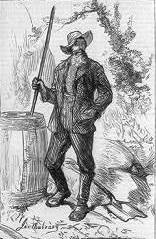This article needs additional citations for verification .(December 2009) |
 Kentucky moonshiner depicted in Harper's Weekly | |
| Regions with significant populations | |
|---|---|
| Appalachia | |
| Religion | |
| Protestantism [1] | |
| Related ethnic groups | |
| White Southerners, Poor White, Scotch-Irish Americans [ citation needed ] |
Mountain whites were white Americans (usually poor) living in Appalachia and the inland region of the Antebellum South. They were generally small farmers, who inhabited the valleys of the Appalachian range from western Virginia spanning down to northern Georgia and northern Alabama. [2]